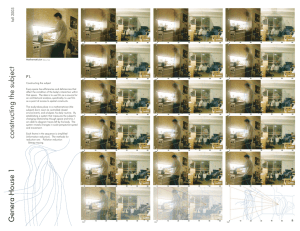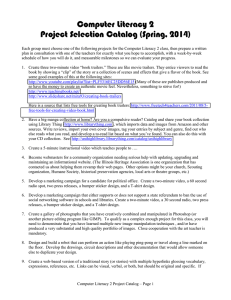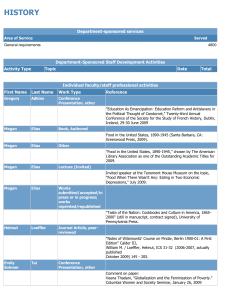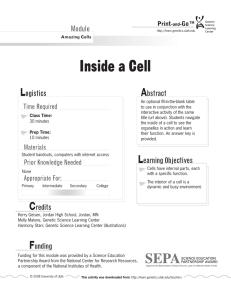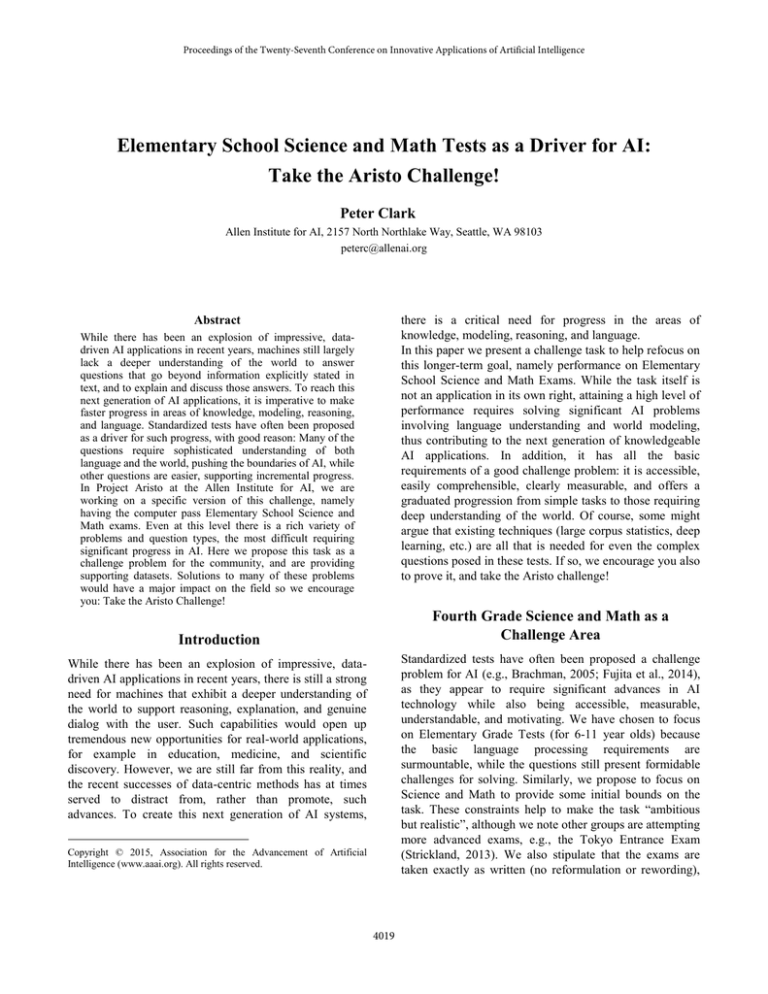
Proceedings of the Twenty-Seventh Conference on Innovative Applications of Artificial Intelligence
Elementary School Science and Math Tests as a Driver for AI:
Take the Aristo Challenge!
Peter Clark
Allen Institute for AI, 2157 North Northlake Way, Seattle, WA 98103
peterc@allenai.org
Abstract
there is a critical need for progress in the areas of
knowledge, modeling, reasoning, and language.
In this paper we present a challenge task to help refocus on
this longer-term goal, namely performance on Elementary
School Science and Math Exams. While the task itself is
not an application in its own right, attaining a high level of
performance requires solving significant AI problems
involving language understanding and world modeling,
thus contributing to the next generation of knowledgeable
AI applications. In addition, it has all the basic
requirements of a good challenge problem: it is accessible,
easily comprehensible, clearly measurable, and offers a
graduated progression from simple tasks to those requiring
deep understanding of the world. Of course, some might
argue that existing techniques (large corpus statistics, deep
learning, etc.) are all that is needed for even the complex
questions posed in these tests. If so, we encourage you also
to prove it, and take the Aristo challenge!
While there has been an explosion of impressive, datadriven AI applications in recent years, machines still largely
lack a deeper understanding of the world to answer
questions that go beyond information explicitly stated in
text, and to explain and discuss those answers. To reach this
next generation of AI applications, it is imperative to make
faster progress in areas of knowledge, modeling, reasoning,
and language. Standardized tests have often been proposed
as a driver for such progress, with good reason: Many of the
questions require sophisticated understanding of both
language and the world, pushing the boundaries of AI, while
other questions are easier, supporting incremental progress.
In Project Aristo at the Allen Institute for AI, we are
working on a specific version of this challenge, namely
having the computer pass Elementary School Science and
Math exams. Even at this level there is a rich variety of
problems and question types, the most difficult requiring
significant progress in AI. Here we propose this task as a
challenge problem for the community, and are providing
supporting datasets. Solutions to many of these problems
would have a major impact on the field so we encourage
you: Take the Aristo Challenge!
Fourth Grade Science and Math as a
Challenge Area
Introduction
Standardized tests have often been proposed a challenge
problem for AI (e.g., Brachman, 2005; Fujita et al., 2014),
as they appear to require significant advances in AI
technology while also being accessible, measurable,
understandable, and motivating. We have chosen to focus
on Elementary Grade Tests (for 6-11 year olds) because
the basic language processing requirements are
surmountable, while the questions still present formidable
challenges for solving. Similarly, we propose to focus on
Science and Math to provide some initial bounds on the
task. These constraints help to make the task “ambitious
but realistic”, although we note other groups are attempting
more advanced exams, e.g., the Tokyo Entrance Exam
(Strickland, 2013). We also stipulate that the exams are
taken exactly as written (no reformulation or rewording),
While there has been an explosion of impressive, datadriven AI applications in recent years, there is still a strong
need for machines that exhibit a deeper understanding of
the world to support reasoning, explanation, and genuine
dialog with the user. Such capabilities would open up
tremendous new opportunities for real-world applications,
for example in education, medicine, and scientific
discovery. However, we are still far from this reality, and
the recent successes of data-centric methods has at times
served to distract from, rather than promote, such
advances. To create this next generation of AI systems,
Copyright © 2015, Association for the Advancement of Artificial
Intelligence (www.aaai.org). All rights reserved.
4019
Answering this question requires knowledge that eating
involves taking in nutrients, and that an apple contains
nutrients.
so that the task is clear. Finally we propose to use
Standardized Tests, rather than synthetic tests such as the
Winograd Schema (Levesque et al., 2013) or MCTest
(Richardson et al., 2013), as they provide a natural sample
of problems, and more directly suggest real-world
applications in the areas of education and science.
More Complex World Knowledge
Many questions appear to require both richer knowledge of
the world, and appropriate linguistic knowledge to apply it
to a question. As an example, consider the question below:
The New York Regents Science Exams:
A Short Guided Tour
Fourth graders are planning a roller-skate race. Which
surface would be the best for this race? (A) gravel (B)
sand (C) blacktop (D) grass
One of the most interesting and appealing aspects of
Elementary Science exams is their graduated and multifaceted nature: Different questions explore different types
of knowledge and vary substantially in difficulty (for a
computer), from a simple lookup to those requiring
extensive understanding of the world. This allows
incremental progress while still demanding significant
advances for the most difficult questions. Information
retrieval and bag-of-words methods work well for a subset
of questions but eventually reach a limit, leaving a
collection of questions requiring deeper understanding. We
illustrate some of this variety here, using the multiple
choice part of the NY Regents 4th Grade Science exams
(NYSED, 2014). For a more detailed analysis, see (Clark et
al., 2013).
Strong correlations between sand and surface, grass and
race, and gravel and graders (road smoothing machines),
throw off information retrieval-based guesses. Rather, a
more reliable answer requires knowing that a roller-skate
race involves roller skating, that roller skating is on a
surface, that skating is best on a smooth surface, and that
blacktop is smooth. Obtaining these fragments of world
knowledge and integrating them correctly is a substantial
challenge.
As a second example, consider the question:
A student puts two identical plants in the same type and
amount of soil. She gives them the same amount of
water. She puts one of these plants near a sunny window
and the other in a dark room. This experiment tests how
the plants respond to (A) light (B) air (C) water (D)
soil
Basic Questions
Part of the NY Regents exam tests for relatively
straightforward knowledge, such as taxonomic ("isa")
knowledge, definitional (terminological) knowledge, and
basic facts about the world. Example questions include:
Again, information retrieval methods and word
correlations do poorly. Rather, a reliable answer requires
recognizing a model of experimentation (perform two
tasks, differing in only one condition), knowing that being
near a sunny window will expose the plant to light, and
that a dark room has no light in it.
Finally, consider the question:
The movement of soil by wind or water is called (A)
condensation (B) evaporation (C) erosion (D) friction
Which part of a plant produces the seeds? (A) flower (B)
leaves (C) stem (D) roots
A student riding a bicycle observes that it moves faster
on a smooth road than on a rough road. This happens
because the smooth road has (A) less gravity (B) more
gravity (C) less friction (D) more friction
This style of question is amenable to solution by
information retrieval methods and/or use of existing
ontologies or fact databases, coupled with linguistic
processing.
A reliable processing of this question requires envisioning
and comparing two different situations, overlaying a
simple qualitative model on the situations described
(smoother less friction faster). It also requires basic
knowledge that bicycles move, and that riding propels a
bicycle.
Simple Inference
Many questions are unlikely to have answers explicitly
written down anywhere, from questions requiring a
relatively simple leap from what might be already known
to questions requiring complex modeling and
understanding. An example requiring (simple) inference is:
Diagrams
Which example describes an organism taking in
nutrients? (A) dog burying a bone (B) A girl eating an
apple (C) An insect crawling on a leaf (D) A boy
planting tomatoes in the garden
A common feature of many Elementary Grade exams is the
use of diagrams in questions. We choose to include these
in the challenge because of their ubiquity in tests, and
because spatial interpretation and reasoning is such a
4020
IXQGDPHQWDO DVSHFW RI LQWHOOLJHQFH 'LDJUDPV LQWURGXFH
VHYHUDO QHZ GLPHQVLRQV WR TXHVWLRQDQVZHULQJ LQFOXGLQJ
VSDWLDO LQWHUSUHWDWLRQ DQG FRUUHODWLQJ VSDWLDO DQG WH[WXDO
NQRZOHGJH 'LDJUDPPDWLF QRQWH[WXDO HQWLWLHV LQ
HOHPHQWDU\ H[DPV LQFOXGH VNHWFKHV PDSV JUDSKV WDEOHV
DQG GLDJUDPPDWLF UHSUHVHQWDWLRQV HJ D IRRG FKDLQ
5HDVRQLQJ UHTXLUHPHQWV LQFOXGH VNHWFK LQWHUSUHWDWLRQ
FRUUHODWLQJ WH[WXDO DQG VSDWLDO HOHPHQWV DQG PDSSLQJ
GLDJUDPPDWLFUHSUHVHQWDWLRQVJUDSKVEDUFKDUWVHWFWRD
IRUPVXSSRUWLQJFRPSXWDWLRQ$JDLQZKLOHWKHUHDUHPDQ\
FKDOOHQJHVWKHOHYHORIGLIILFXOW\YDULHVZLGHO\DOORZLQJD
JUDGXDWHGSODQRIDWWDFN7ZRH[DPSOHVDUHVKRZQEHORZ
WKH ILUVW UHTXLUH VNHWFK LQWHUSUHWDWLRQ SDUW LGHQWLILFDWLRQ
DQGODEHOSDUWFRUUHODWLRQ7KHVHFRQGUHTXLUHVUHFRJQL]LQJ
DQGLQWHUSUHWLQJDVSDWLDOUHSUHVHQWDWLRQ
6XFKTXHVWLRQVFOHDUO\FDQQRWEHDQVZHUHGE\LQIRUPDWLRQ
UHWULHYDO DQG LQVWHDG UHTXLUH V\PEROLF SURFHVVLQJ DQG LQ
WKH ODWWHU FDVH DOLJQPHQW RI WH[WXDO DQG GLDJUDPPDWLF
HOHPHQWVHJ6HRHWDOIROORZHGE\LQIHUHQFH
0DNLQJWKH&KDOOHQJHD5HDOLW\
'HVSLWH WKH VXFFHVVHV RI GDWDGULYHQ $, V\VWHPV LW LV
LPSHUDWLYH WKDW ZH PDNH SURJUHVV LQ DUHDV RI NQRZOHGJH
PRGHOLQJ UHDVRQLQJ DQG ODQJXDJH LI ZH DUH WR PDNH WKH
QH[WJHQHUDWLRQRINQRZOHGJDEOH$,DSSOLFDWLRQVDUHDOLW\
(OHPHQWDU\*UDGH7HVWVSUHVHQWPDQ\RIWKHVHFKDOOHQJHV
\HW DUH DOVR DFFHVVLEOH FRPSUHKHQVLEOH LQFUHPHQWDO DQG
HDVLO\PHDVXUDEOH,WVKRXOGEHQRWHGWKRXJKWKDWWKH\GR
QRW FRYHU DOO DVSHFWV RI LQWHOOLJHQFH IRU H[DPSOH
VSDWLDONLQHPDWLF UHDVRQLQJ VRPH W\SHV RI FRPPRQVHQVH
UHDVRQLQJ DQG LQWHUDFWLRQGLDORJ DUH XQGHUUHSUHVHQWHG RU
DEVHQW'DYLVDQGWKXVWKHH[DPVGRQRWFRQVWLWXWH
D IXOO 7XULQJ 7HVW DV D WHVW RI PDFKLQH LQWHOOLJHQFH WKH\
DUHQHFHVVDU\EXWQRWVXIILHQW1RQHWKHOHVVWKH\GRFRYHUD
ZLGH YDULHW\ RI SUREOHP W\SHV DQG OHYHOV RI GLIILFXOW\
PDNLQJWKHPDQLGHDOGULYHUIRUSXVKLQJWKHILHOGIRUZDUG
2I FRXUVH VRPH PD\ FODLP WKDW H[LVWLQJ GDWDGULYHQ
WHFKQLTXHV DUH DOO WKDW LV QHHGHG IRU WKLV FKDOOHQJH JLYHQ
HQRXJKGDWDDQGFRPSXWLQJSRZHULIWKDWZHUHVRWKDWLQ
LWVHOI ZRXOG EH D VWDUWOLQJ UHVXOW :KDWHYHU \RXU ELDV RU
SKLORVRSK\ZHHQFRXUDJH\RXWRSURYH\RXUFDVHDQGWDNH
WKH$ULVWR&KDOOHQJH
:KLFK OHWWHU LQ WKH GLDJUDP ULJKW
SRLQWVWRWKHSODQWVWUXFWXUHWKDWWDNHV
LQZDWHUDQGQXWULHQWV"
:KLFK GLDJUDP EHORZ FRUUHFWO\
VKRZVWKHOLIHF\FOHRIVRPHLQVHFWV"
$YDLODELOLW\7KH$ULVWRFKDOOHQJHGDWDVHWVDUHDYDLODEOHDW
ZZZDOOHQDLRUJ
5HIHUHQFHV
%UDFKPDQ HW DO 6HOHFWHG *UDQG &KDOOHQJHV LQ &RJQLWLYH
6FLHQFH0,75(7HFKQLFDO5HSRUW
&ODUN 3 +DUULVRQ 3 %DODVXEUDPDQLDQ 1 $ 6WXG\ RI WKH
.QRZOHGJH %DVH 5HTXLUHPHQWV IRU 3DVVLQJ DQ (OHPHQWDU\
6FLHQFH7HVW,Q$.%&
'DYLV ( 7KH /LPLWDWLRQV RI 6WDQGDUGL]HG 6FLHQFH 7HVWV DV
%HQFKPDUNV IRU $, 5HVHDUFK 1<8 7HFKQLFDO 5HSRUW KWWSDU[LYRUJDEV
)XMLWD $ .DPHGD $ .DZD]RH $ 0L\DR < 2YHUYLHZ RI
7RGDL5RERW3URMHFWDQG(YDOXDWLRQ)UDPHZRUNRILWV1/3EDVHG
3UREOHP6ROYLQJ,Q3URF/5(&
/HYHVTXH+'DYLV(0RUJHQVWHUQ/7KH:LQRJUDG6FKHPD
&KDOOHQJH$$$,
1<6(' ³7KH *UDGH (OHPHQWDU\/HYHO 6FLHQFH 7HVW´
KWWSZZZQ\VHGUHJHQWVRUJ*UDGH6FLHQFHKRPHKWPO
5LFKDUGVRQ 0 %XUJHV & 5HQVKDZ ( 0&7HVW $ &KDOOHQJH
'DWDVHWIRUWKH0DFKLQH&RPSUHKHQVLRQRI7H[W(01/3
6HR 0 +DMLVKLU]L + )DUKDGL $ (W]LRQL 2 'LDJUDP
8QGHUVWDQGLQJLQ*HRPHWU\4XHVWLRQV$$$,
6WULFNODQG(&DQDQ$,*HW,QWRWKH8QLYHUVLW\RI7RN\R",(((
6SHFWUXP$XJXVW
0DWKHPDWLFVDQG*HRPHWU\
$V D ILQDO HOHPHQW ZH LQFOXGH HOHPHQWDU\ PDWKHPDWLFV
DQG KLJK VFKRRO JHRPHWU\ TXHVWLRQV LQ RXU FKDOOHQJH
VFRSH DV WKHVH TXHVWLRQV LQWULQVLFDOO\ UHTXLUH PDSSLQJ WR
PDWKHPDWLFDO PRGHOV D NH\ UHTXLUHPHQW IRU PDQ\ UHDO
ZRUOGWDVNV7KHVHTXHVWLRQVDUHSDUWLFXODUO\LQWHUHVWLQJDV
WKH\ FRPELQH HOHPHQWV RI ODQJXDJH SURFHVVLQJ RIWHQ
VWRU\ LQWHUSUHWDWLRQ PDSSLQJ WR DQ LQWHUQDO UHSUHVHQWDWLRQ
HJDOJHEUDDQGV\PEROLFFRPSXWDWLRQ)RUH[DPSOH
0ROO\ RZQV WKH :DIWLQJ 3LH &RPSDQ\ 7KLV PRUQLQJ
KHU HPSOR\HHV XVHG HJJV WR EDNH SXPSNLQ SLHV ,I
KHU HPSOR\HHV XVHG D WRWDO RI HJJV WRGD\ KRZ
PDQ\ HJJV GLG WKH\ XVH LQ WKH
DIWHUQRRQ"
,Q WKH GLDJUDP $% LQWHUVHFWV
FLUFOH 2 DW ' $& LQWHUVHFWV
FLUFOH2DW($( $& DQG$% )LQG$'
4021




